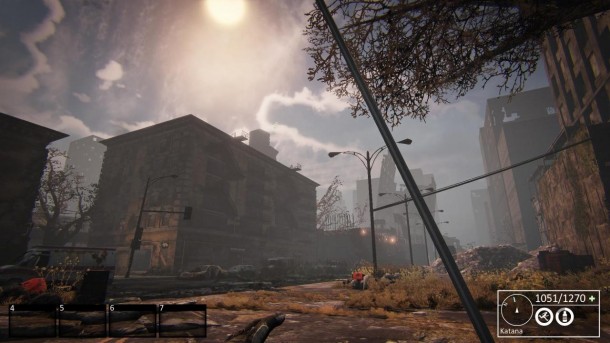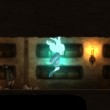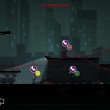Nether Review
The popularity of postapocalyptic survival games has been explosive, and it has become increasingly critical to offer a fresh take or risk being lost in the bedlam. Nether, however, is a first-person online survival shooter that doesn't strive to reinvent the wheel. It approaches the challenge by introducing tried-and-true ideas, mashing them together in hopes that the sum of its acclimated parts results in a bright entry in the well-trodden genre. What emerges is a concoction that vacillates between amusement and listlessness. Nether employs many ideas that, alone, could have produced enjoyable gameplay, but what ultimately surfaces is a game whose fun, interesting moments are undermined by frustration.
Nether exhibits influences from popular postapocalyptic television shows and films. The Chicago-inspired urban sprawl of the city portions of the game are home to cracked, ruined skyscrapers and flooded streets. Vehicles, covered in rust and abandoned by their owners, litter enormous freeways in a scene that could have been plucked from early advertisements for The Walking Dead. Scattered throughout the world are safe zones, hastily erected out of metal barriers or standing high on platforms. Final bastions of humankind, safe zones are places similar to the cobbled structures seen in films like The Day of the Dead. Here, you are safe from harm (mostly, but more on that later) and can buy and sell gear, craft weapons, and complete courier missions.
Despite the familiar world in which Nether exists, I found the varied urban environments the highlight of my forlorn adventures. As is the custom of survival games, you are released into the desolate world of Nether, where you're greeted by ruined buildings and charred skeletons. No explanation behind the tragedy is freely offered, only a large kitchen knife and a lime-green backpack, the latter of which does little to assist you in blending into the brown and gray of the decayed urban landscape. Scattered throughout the broken concrete world are signs of the desperation that soon followed whatever unearthly disaster occurred years prior. Emergency vehicles sit dormant, their flashing lights cutting through the dust and fog.
Elsewhere lay signs that people had attempted to carve out an existence, either in peaceful solitude or in ruthless, violent gangs--both of which ultimately met a macabre and bloody demise. The world is bleak, dark, often gorgeous, and well realized. I embraced the excitement and apprehension as I darted into buildings or sprinted over dangerous, empty streets while scrounging for food or gear locked away in various objects such as vending machines or abandoned vehicles. Some minor gripes include buildings that are clearly copied and pasted, and structures that cannot be entered.

But those issues don't hamper the entertainment much. Adding to the interest is the ambient weather system, which can influence how you approach situations. More than once, I would scout an area I needed to visit. I noted pathways to keep me hidden, along with enemies to avoid. But suddenly a cloud of rust-colored dust would roll in, and the loss of vision would force me to drastically alter my advancement. Nether's fluctuating world feels like a living entity, always plotting against you.
It's unfortunate that the immersion is so often broken by nagging issues, coupled with the reality of Nether's clearly unfinished state. Oddly placed invisible walls stop you short mid-sprint, which makes pacing anything but fluid. Piles of rubble and trash are commonplace, which is not strange considering the game's motif. What is odd, however, are the invisible barriers surrounding the debris. Walking over the piles is possible, though doing so positions you several feet in the air. Your movement speed is also drastically slowed in these situations, turning you into an easy target for predators. It is also possible to clip completely into certain objects, such as cabinets, computer desks, or rubble, as well as some knee-high gates, as if they weren't even there. The fields west of the city may seem like a respite from such urban difficulties, but they are nearly barren and devoid of food and resources--save for the military grain silo, a popular site for random weapon spawns. There are towers to capture if you're part of a clan, as well as safe zones to which you can transport packages. I found myself avoiding the area completely and sticking to the more interesting urban locations.
Scattered throughout the broken concrete world are signs of the desperation that soon followed whatever unearthly disaster occurred years prior.
The creatures that populate the world following the collapse of society are the titular nethers. These mutated abominations come in many forms and charge with sharp claws, blunt fists, or blinding toxic sludge. Running is not always an option, because the monsters possess the ability to dive into a portal, exiting just behind your back and slashing away at you. These abilities make nethers more threatening than the average shuffling zombie. But some of the danger they pose also comes from their hypersensitive threat detection.
Nethers have the uncanny ability to "sense" you through stone, asphalt, and metal. You might believe you're alone as you move through an empty building, but suddenly a deafening screech informs you that a nether is on your tail. It can get frustrating, especially if you're being careful not to get spotted while you go about your current goal, whether it's traveling to a location or searching around for loot. Killing the creatures makes them drop organic parts such as blood or claws, which can then be sold or traded at the Order of the Cull, a mysterious group that exchanges nether viscera for gear. The order can also craft weapons from nether bones, once you gather enough severed parts.
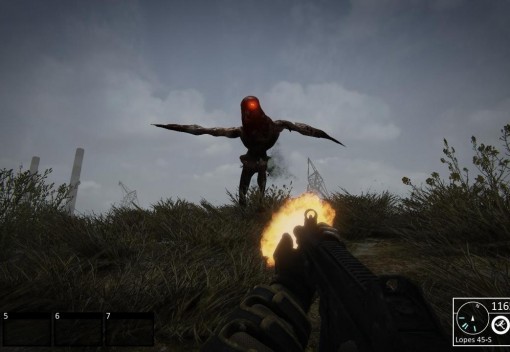

More dangerous than the nethers are the human players who populate the world with you. Encounters with players are rarely analogous to those in other survival games such as DayZ, where you can consider teaming up with people, or tie them up and force-feed them any noxious chemicals in the area if you're feeling especially sadistic. But there is still a chance for a budding friendship in that harsh world. Not once, however, in my entire 30-hour run in Nether did I experience a confrontation that did not result in one player trying to immediately kill another; the game is the epitome of the "kill or be killed" axiom. Especially frustrating are times when snipers camp just outside the protective sphere surrounding safe zones and pick off players just as their protection timer reaches zero. Shouting "friendly," the multiplayer-game-wide attempt at offering an olive branch of peace, is generally rewarded with a hail of gunfire. Camaraderie is rarely experienced, even during in-game missions.
On occasion, Nether starts a timed mission and places you randomly on the map. You receive periodic warnings of a nether surge in need of clearing or an escort package to deliver. The game's version of a boss, the nether reaper, a massive and shockingly fast beast, also appears at times, providing a challenge for veteran players or groups. If you join a clan, you can take out one of many strategically placed clan strongholds in a mode that mimic's Battlefield 4's Conquest mode. These missions can put Nether experts through their paces, and the game suggests grouping up to complete them. Unless you play with friends, or manage to band a small team together, however, players' general proclivity toward violence in Nether makes working collectively to complete missions difficult.
It's unfortunate that the immersion is so often broken by nagging issues, coupled with the reality of Nether's clearly unfinished state.
Worst of all are the times defenses in safe zones drop and you must reactivate pieces of machinery to get them back up. The game, it seems, expects players to work together in this dire time of need. But with defenses gone, people are free to shoot each other indiscriminately. So you can get where this is leading. Only once in several instances did I witness players working together with the goal of reviving the safe zone. Every other time was a massacre, and only the smartest (or fastest) players were able to get out before being gunned down.
I found that having enough people in a server was necessary for enjoyment, however. Sure, a fellow player who offers a friendly wave in a safe zone might later greet you with that hand tightly wrapped around the grip of a gun. But without the tension that can only be delivered by random encounters with actual living players, the game devolves into a long and uneventful trek through austere scenery. I enjoyed exploring the game's environments, but I eventually got bored and went on the hunt for populated servers when the one I inhabited began to droop.
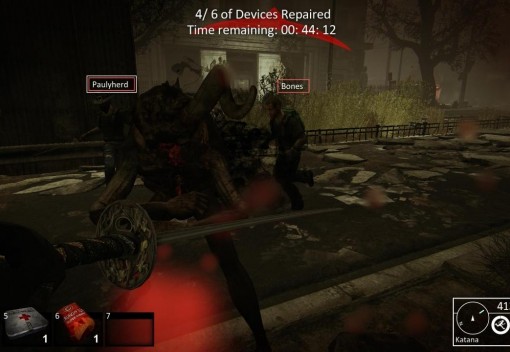
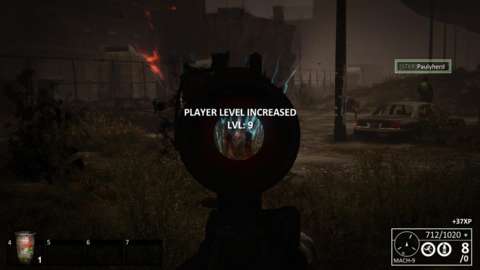
To survive in the hostile world of Nether, you must equip yourself with the proper tools. Guns and melee weapons are not in short supply, though the former requires you to collect parts. Weapon parts, such as grips, barrels, and scopes, are found in containers located in the environment. When the parts are gathered, you can take them to a weapon crafter in any of the safe zones, where your brand-new gun will be assembled for free. Nether sports a wide variety of guns, from the always reliable 9mm Smith & Risley pistol, to a diverse selection of rifles and shotguns.
You start out with a basic knife, but to face tougher enemies, a stronger melee weapon is crucial. Melee weapons are sometimes found intact in some containers, but I was partial to purchasing them for a reasonable fee. Close-range combat is enjoyable, and you can feel the weight behind each swing of a machete or baseball bat. But guns are on the opposite end of the spectrum. They are powerful, but far too accurate, and they demonstrate next to nothing in the way of recoil. The guns bear more resemblance to weapons found in arena shooters, and fired bullets can be dodged by jumping around like a rabbit--a tactic adopted by veteran Nether players.
Completing missions and delivering packages awards you with cash and experience points. The experience points are used to bolster specific skills, such as stamina, accuracy, or melee damage. The game also awards you with a cash and experience point booster for every half an hour you're alive. And as is par for the course, rising in level is another joy that Nether likes to snatch away. Dying takes you back down to zero, which adds a lot of pressure the higher your level climbs. Going from level 25 back down to zero is frustrating, but luckily leveling up doesn't take much time. However, the constant sting of progression loss begins to have a numbing effect, and earning levels is quickly deprived of any gratification. You also have an account level, which isn't lost at death, but it advances far more slowly; I managed about one level per two hours. The account level adds permanent status boosters, and offers cash bonuses.
Only once in several instances did I witness players working together with the goal of reviving the safe zone.
Money can be spent on gear or food, or on cosmetic items such as masks, some of which pay homage to pop culture icons. Nether also includes a system in which you can exchange real-world money for nether gold, and you can buy special game packages from the Steam store that include this special currency. The gold does not go toward weapons, however, only cosmetic items; it's included for those who are too impatient to save up money to cosplay as Deadpool or the Master Chief.
Nether plays host to a number of glitches and irritating hang-ups. The game's engine isn't well optimized, and even if your computer is used to high-tier games, it will still struggle to render Nether's world. You can't swim, at least not in any traditional sense. Trying to tread water found in the western fields can get you hopelessly stuck, and drowning is an agonizingly slow process. If you need to bypass channels, you must hit the water while jumping to mimic the act of swimming. If you emerge alive, the water blurs your vision with a blue filter that lasts for around five seconds. Worse than that are sticking keys, which once caused me to accidentally walk out of a hole on the side of a multistory sky scraper. If you're up to the task, you can seek out Nether's infamous dune buggy, which has, uh, a few kinks that need to be ironed out. One you find it, the warning "USE AT YOUR OWN RISK" pops up onscreen. Some players have dubbed it the "buggy buggy," because driving it is a glitch-infused nightmare.
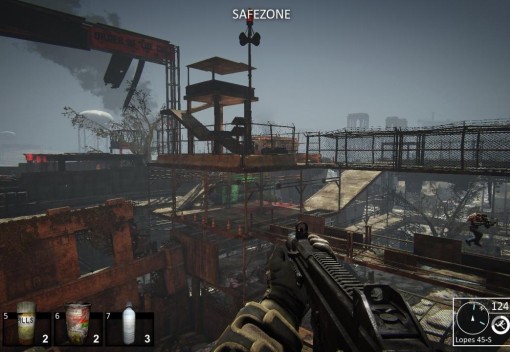
Regardless of everything that drags the game down, Nether provides some compelling moments and creates stories to share. Some of my favorite tales are composed of times I felt the desire to leave the streets and travel to my destination using the often underused subway system. The silence in the tunnels was therapeutic after the tension on the surface, for a time. In the subway, flickering lights supplement the lonely sound of your footsteps, which is abruptly broken by noise from the surface. Just above your head comes the sound of screeching demons, followed by the sharp crack of gunfire and then silence. The reality of the situation is enough to snap you back into focus, as it must, because soon the tunnel ends, and you once again have to face the light.
Such moments are fleeting, however, and dissipate just as you get accustomed to their sudden, yet welcome, company. Nether is noticeably unfinished, and has a lot of work ahead before it resembles a solid game. But it has a discernible spark of life. There is potential for it to become a game worthy of attention. The environment it presents is huge, and the grayed-out portions of the map serve to tease you with even more areas to explore, and stories to create, in its bleak, abysmal, yet interesting world. If only it can learn to stop tripping over its own feet.

